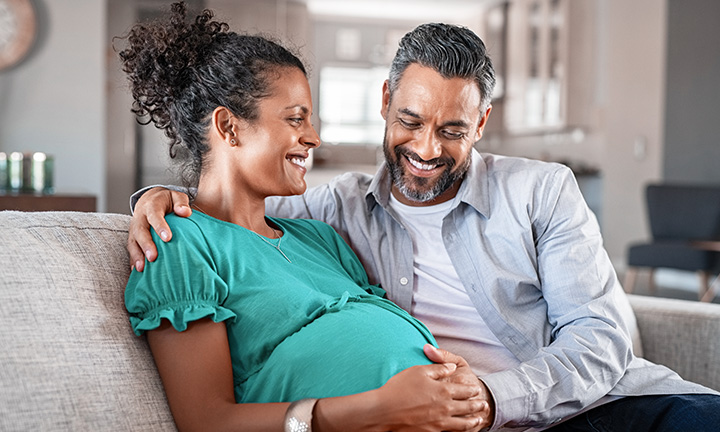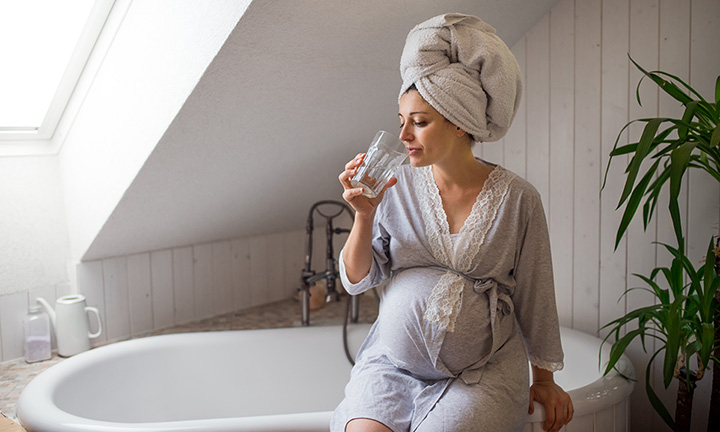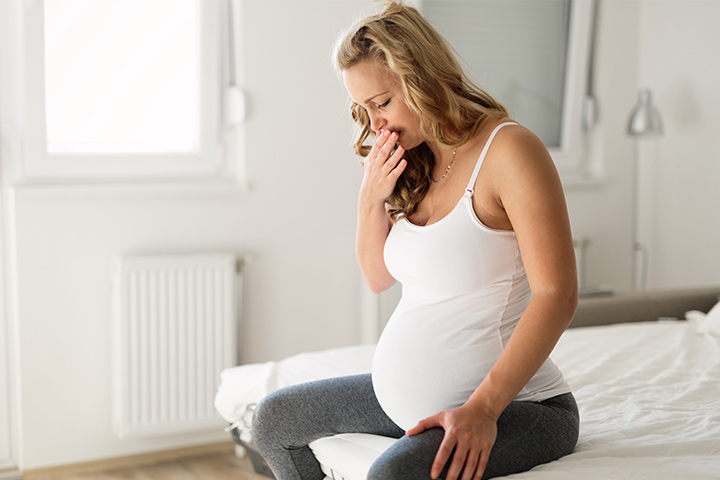
How Your Baby Bump Grows Week by Week
The moment you discover you’re pregnant, your thoughts and attention become focused on your belly. There’s something comforting about snuggling with your baby bump, even before it starts to appear. Plus, you're understandably eager to see when your little baby bump will start to show, and to learn how your body changes along the way as your pregnancy unfolds! That's why we've created this comprehensive weekly guide to baby bump development and the stages of a pregnancy belly—read on to discover how your belly might grow and expand! And remember, every bump is unique and develops at its own pace.
When Does Your Baby Bump Start to Show?
Throughout your pregnancy, you’ll experience normal changes throughout your body, as well as to your baby bump, and your healthcare provider can help you navigate your entire journey. As the first trimester ends and the second trimester begins, the size of the uterus has increased to the point that it no longer is completely within the pelvis. For many pregnant people, a baby bump might start to appear between weeks 13 and 16, or sometimes even later.
Keep in mind that everyone is different and every pregnancy is unique, with each pregnant belly stage being special. Your baby bump may make its debut earlier or later, and that’s totally normal.
Early Baby Bump Signs
As your baby bump starts to develop, it’s exciting to follow along! Here are a few early signs that your bump is about to show.
Pregnancy Weight Gain Calculator
Fill out your details:
Pregnancy Belly Week by Week
While you're on the lookout for any signs of baby bump growth, your healthcare provider will monitor your progress at your regular prenatal checkups and make sure that you and your baby are staying healthy. At about week 20 of your pregnancy, the provider will start measuring the distance from the pubic bone to the top (fundus) of the uterus, which is called the fundal height measurement.
Tracking fundal height gives the healthcare provider a way to assess your baby's size and growth rate. The measurement (in centimeters) roughly equals the week of pregnancy; in week 20, for instance, your fundal height may be about 18 to 22 centimeters.
Here, we’ve set out guidelines for how your pregnant belly may grow and how your body might change week by week. You can also check out our pregnancy calendar for more details on the weeks, months, and trimesters of pregnancy.
Weeks 1 to 4: The First Moments
You likely won't spot any baby bump growth within the first weeks of pregnancy. Your healthcare provider will most likely calculate your due date from the start of your last menstrual period, which means that, depending on when you ovulate and when conception occurs, you may not actually be pregnant for the first week or two. Here’s a little insight into the first weeks of pregnancy:
Summary
When does your baby bump start to show? Not usually in the first weeks, but that doesn’t mean important things aren’t happening! The uterine wall will thicken, and hormones will kick into gear to prepare for your developing baby. Don’t be alarmed if you notice some spotting.
Weeks 5 to 8: Early Signs of Pregnancy
Maybe your first few weeks of pregnancy went by without much change, but you may start to finally “feel” pregnant during weeks 5 to 8. Around this time, it’s common to experience some typical pregnancy symptoms like morning sickness or fatigue, but you probably won't see a baby bump emerge.
Summary
You still might not notice a baby bump yet, but there are other changes going on. Although early signs of pregnancy like nausea, heartburn, and fatigue aren't always fun, think of them as signs of progress!
Weeks 9 to 12: Your Changing Shape
Once you enter 9 weeks of pregnancy, you officially have a little fetus growing inside you! At this point, you may be wondering when your baby bump will start to show.
Keep an eye on your profile for any slight weight gain or growth above your pelvis. By weeks 11 or 12, you might have gained about 1. Don't stress if you've gained more or even lost weight. Everyone's different, and morning sickness and food aversions can affect early weight changes. 5 pounds. Everyone is different, and morning sickness and food aversions can impact early weight gains and losses. Here are some things you might notice during this period:
Summary
There’s a chance your baby bump will make its debut sometime soon, but don’t worry if it hasn’t emerged quite yet. If anything, you may notice some normal weight gain, such as a little extra fat in your waist.
Weeks 13 to 16: A Little Baby Bump
Congratulations on reaching the second trimester of your pregnancy! Many refer to this time as the “honeymoon period” because it's when most people feel their best. You might notice that your baby bump is starting to show, as your baby is growing quickly.
You may feel less worried and more confident now, given that the risk of pregnancy loss drops after the first three months. You might even be ready to start sharing the news! There are many creative ways to announce your pregnancy if and when you’re ready.
At about 14 weeks, your baby's reproductive system is shaping up. But when it comes to a baby boy vs baby girl belly bump, there’s not much difference in terms of belly shape or growth. What can impact the shape or size of your baby bump is the weight and positioning of the fetus, not the gender. For example, if the fetal position is slightly sideways, your pregnancy belly may appear wider rather than longer.
Summary
If you’re tracking your baby bump by week, this is most likely the time you will notice some growth, and you may also spot some skin darkening, such as the linea nigra, a dark line that runs down your belly. Morning sickness may start to subside, but your uterus is expanding, so don’t be surprised if you feel some pain in your lower abdomen.
Weeks 17 to 20: The Halfway Mark
At this point in your pregnancy, your baby will experience quite a bit of development, and you may see the same with your bump! You might even start to feel your baby move and kick—a joyful experience and a sign that all is well.
At week 20, you’re basically at the halfway mark of your pregnancy. You can start to track your baby bump as your healthcare provider begins to monitor fetal development by taking fundal height measurements.
Summary
Your growing baby bump can lead to a little discomfort or pain as your uterus moves and expands. It’s always a good idea to consult your healthcare provider if you have any concerns. On the bright side, you may detect some small baby movements that feel like “butterflies” in your stomach.
Weeks 21 to 24: Faster Baby Growth
As you make your way through the second trimester, you might notice your baby bump expanding by the week! During this month, your baby is growing at a faster pace than before, and at the same time, your hormones are starting to level out.
Summary
As your baby develops, so does your baby bump, and you may notice some standard aches and pains and more weight gain this month. If you experienced any mood swings earlier in your pregnancy, this is when they usually start to subside.
Weeks 25 to 28: Prepping for Labor
You’re edging closer to the third trimester, the final stretch of your pregnancy! If you don’t think you have much of a pregnancy belly yet, that may change quickly in the coming weeks. Your baby is developing rapidly at this point—most baby development (in terms of size) occurs in the final trimester—which can cause some body changes for you, too.
You may feel more kicking and even experience Braxton Hickscontractions, which are often referred to as practice contractions or “false labor. ” This is a good sign that your body is preparing for labor!
Summary
As you enter your third trimester, it’s possible to feel some Braxton Hicks contractions (false labor). This is your body practicing for the process of labor! You may notice some more movements in your belly as your uterus grows even more to accommodate your little one.
Weeks 29 to 32: Pregnancy Glow
Your due date is inching closer, which makes this month quite exciting for you and your baby bump. The third trimester might bring about some new body changes, as your baby bump is expanding and putting more pressure here and there.
Summary
Your uterus will expand up toward your rib cage, potentially changing the shape of your baby bump. Thanks to “pregnancy glow,” your hair might be thicker or fuller, but you may also experience some skin changes. Stretch marks, dark spots, and itchiness are all very common.
Weeks 33 to 36: Getting Into Position
Your baby may arrive soon, and your baby bump probably gives it away. If you’re having multiples, expect your belly to be bigger, as it’s a snuggly home to more than one! Because of this growth, late-stage pregnancy can be a bit uncomfortable, but soon enough, it’ll all be worth it.
If the nesting urge didn’t get you last month, you may experience it more at this point in your pregnancy. Nesting is not just a myth, and it can help you alleviate any stress or anxious thoughts as that baby bump grows. For any physical discomforts, stretching and light exercise, like prenatal yoga, go a long way.
Summary
You’re in the home stretch! You might feel some relief in your upper abdomen as your baby “drops” into position, possibly shifting your baby bump. Typical pregnancy digestive issues like heartburn and constipation might also subside.
Weeks 37 to 40: Almost There
Although an “at term” pregnancy can last 40 or more weeks, passing 39 weeks of pregnancy is the official mark of a full-term pregnancy. If your little one prefers to stay in the coziness of your belly a bit longer, your healthcare provider will keep track of vital signs to make sure all is well.
At this time, you probably need to rest and put your feet up, but you might also feel the urge to put any finishing touches on baby preparation, from decorating the nursery to shopping for all things baby. Downloading the Pampers Rewards app is a great way to get all the essentials (like diapers and wipes) and earn rewards for all your Pampers purchases.
Summary
When tracking your baby bump by week, this is when you’ll see the peak. Your uterus is done expanding, but body changes at this time can be more uncomfortable. Rest, put your feet up, and distract yourself with hobbies or baby prep.
FAQs at a Glance
Pregnancy is different for everyone, but your baby bump may be visible at the beginning or in the middle of the second trimester. If yours appears earlier or later, it’s normal! Consult with your healthcare provider if you have any questions or concerns.
The Bottom Line
Tracking your baby bump by week can be an exciting part of your pregnancy journey. Knowing when your baby bump starts to show is part of the fun! If you’re just starting off, here's where you can get a rough idea about how far along you are in your pregnancy.
There are plenty of ways to prepare for the experience of being pregnant, like learning how to cope with pregnancy fatigue or studying up on the ABCs of pregnancy pains. If you have yet to settle on a name for your little one, get inspired with our Baby Name Generator.
- The American College of Obstetricians and Gynecologists
- Mayo Clinic: Guide to a Healthy Pregnancy










